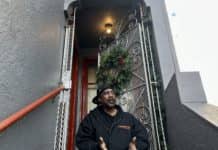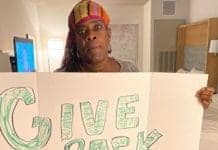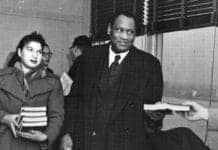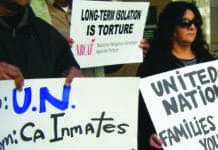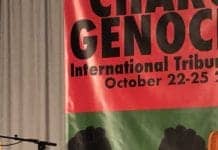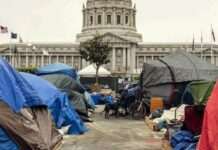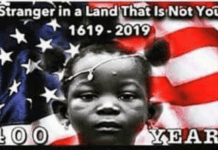
by Tony Robles, The People’s Poet
Hit me with something real. Hit me with what I am. Hit me with my pent-up rage. Hit me with everything that’s been taken from you, me, us – our city. Last Black man, first Black man, and all Black men in between; hit me in the solar nexus, the crossroads, the migration, the displacement, the toxicity – I want it all, I want it all back.
“Last Black Man in San Francisco,” a pause in the sound of the heartbeat of two young Black men, a pause that expands and captures the history of a people – the Black community of San Francisco – in all its love and anger and brilliance and contradictions. In a city that has betrayed its Black community for all to see, “The Last Black Man in San Francisco,” through art and respect for what has come before – the foundation upon where we stand – sings a song of dignity of our Black community – a dignity that is under attack without relenting.
Remember your truth in the city of facades
As a born and raised San Franciscan, I see Black faces every day in my city, faces that show the history of neglect, the forgotten faces, disrespected faces, faces paved over with scars – faces that have become a landmark of the city’s shame. In the pause of chaos, we see the toxicity of indifference that is so thick in the San Francisco air that one must wear a hazardous material suit to navigate it.
“The complexity of Black laughter and view of the world – unique to Frisco (yes Frisco) – gets erased without an afterthought.”
But I also, in the madness of the city, see in it – what my friend and activist David Woo describes as “Frisco humbleness” – a going with the flow and surviving without forgetting who you are and where you came from. This movie comes with a big dose of “Frisco Humbleness.”
In the backdrop of Hunters Point, at the movie’s outset, a community prophet-preacher warns: “We were put through hell to be purified!” In the eyes of two young men, best friends – Jimmie and Mont (played by Jimmie Fails and Jonathan Majors) – the quest for purification begins.
The writer James Baldwin – who visited San Francisco in the early ‘60s as part of a documentary and who immediately sensed its subtle yet toxic racism – wrote that if one can describe one’s environment, one can control it. To describe it, one must pause and reclaim what is one’s own through new eyes – and what is to be reclaimed is community.
To pause when a white person appears out of nowhere and asks, “What are you doing here?” A pause containing the complexities of surviving a place that doesn’t want you, intent on stripping you of your dignity – if you are Black – by its bureaucracies and systems whose very existence depends upon the disdain it holds towards you.
The dignity and complexity of caring for a home that was lost, a brush, applying paint, adding color to what has been stripped, reclaiming a home, reclaiming a self, an identity; loving a house no longer yours so much that you know that the new occupants do not love it as you do, do not know it as you do, do not have the same respect for it as you and your family did.
‘Our sweat is soaked in the wood’
A pause in the mirror, in the drama of street corner conflicts and dramas that pull us down and build us up – giving birth to and destroying us – in postures and phrases and bullets and blessings and finally an embrace and tears and wails that never end – wet with the salty water of the Bay which is in our blood. “Hit me bruh!” one young Black brother dares another.
Challenging one’s courage, one’s manhood – with voices that slash, cut – leaving scars that cover the scars inside, worn with honor as the streets are carved from under us. Again, the preacher-prophet who sees the lurking powers of the toxic Bay, the toxic cloud who warns: They got plans for us!
Why does renewal often bring with it a renewed sense of death? As James Baldwin said, it is the report of the artist, and the report that only the artist can give that is, in the end, our only hope in showing anybody who makes it to this planet how to survive it.
The constant play, the drama acted out day after day, seen through the eyes of Mont, a playwright – acting it out in Hunters Point on a wooden plank, in a landscape where we all play our part in a drawn out tragedy that is the city of St. Francis. Mont lives with his grandpa (Played by Danny Glover) who is blind.
They sit together – along with Jimmie – watching old mystery movies to which Mont describes the action – scene by scene. In the small room he shares with Jimmie, he sketches the people and places of his neighborhood, and is inspired to write a play about a young brother named Kofi.
Upon the tragic death of Kofi – who often gathered with other young men of the neighborhood – a young man with the words “Life after Life” tattooed on his chest – the question the playwright poses is: What if Kofi could have shown all forms of himself? Followed by the declaration: He was put into a box!
Kofi is one of many who live with the lingering and present trauma of eviction, displacement, environmental racism and a tech industry without accountability in a city whose continued hostility towards communities of color, the same communities that made the city great, manifests itself in laws that target poor people and result in the loss of community, a loss of spirit and dignity. The complex lives, the traditions, the complexity of Black laughter and view of the world – unique to Frisco (yes Frisco) – gets erased without an afterthought in the most impersonal way which has become signature San Francisco.
From this place, they hop on a skateboard or on Muni to Jimmie’s family home in the Fillmore – a home that the family lost – encountering a changing neighborhood that is less Black. He reoccupies the home and, for a time, brings it to life after the former occupants lost it in an estate battle.
In occupying the home, Jimmie and Mont bring their complexities and emotion and creativity in the most befitting of places – as rightful occupants. Then, ultimately, there is the threat of police by a real estate agent intent on making a profit – who has tossed Jimmie’s possessions onto the sidewalk – a scenario that is played out over and over in the city.
And there is still love, despite the toxicity of the city, one that doesn’t love you when, on a bus, a pair of transplants speak disparagingly of the city. Jimmie, the young Black man whose life is in the walls of the house that he believes his grandfather built, a house that he is trying to reclaim, interrupts the pair and says, “Do you love it? You don’t get to hate San Francisco unless you love it,” to which there is silence.
“The Last Black Man in San Francisco” was co-written by actor Jimmie Fails, who plays Jimmie in the movie. Fails fails to rely on stereotypes, he fails to overlook complexity, he fails to overlook his elders, he fails to show disrespect to what came before him. He succeeds, as does the cast, producers and writers, in creating a film with much love and grace.
I can still hear the voice of Mike Marshall, singing his rendition of Scott McKenzie’s “San Francisco”:
“If you’re going to San Francisco
“Be sure to wear some flowers in your hair
“If you’re going to San Francisco
“You’re gonna meet some gentle people there.”
Gentle …
The gentle people surely appear in this movie. However, offscreen, they are getting harder to come by in this city.
© 2019 Tony Robles. Contact him at tonyrobles1964@hotmail.com.

 Store
Store



